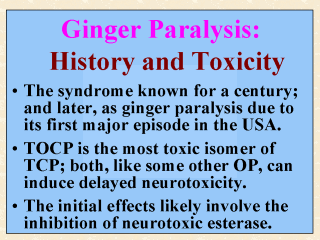| front |1 |2 |3 |4 |5 |6 |7 |8 |9 |10 |11 |12 |13 |14 |15 |16 |17 |18 |19 |20 |21 |review |
 |
As stated in
Ecobichon (1996), the syndrome like ginger jake paralysis has been known for a
century. It is a delayed neurotoxicity, especially that induced by organophosphates (OP).
The initial symptoms are characterized by muscle weakness in the arms and legs, eventually
leading to clumsy, shuffling gait, hyperreflexia, and even a permanent damage to the
pyramidal tracts. The syndrome is later known as ginger jake paralysis due to its
first major epidemic resulting from the consumption of an illegal alcohol Jamaica ginger
jake contaminated with the OP ester tri-ortho-cresyl phosphate (TOCP). The biochemistry and toxicity of TOCP (available as a colorless liquid) were studied extensively soon after the syndrome was associated with the ginger jake episode. TOCP is apparently the most toxic isomer of tricresylphosphate (TCP), the latter also being available as an industrial chemical with numerous commercial applications. TCP is relatively nontoxic and has been widely used as a lubricant, gasoline additive, plasticizer, and flame retardant. TCP as well as TOCP, together with some OP, can induce a delayed neuropathy after a single dose. The initial effects of these OP do not seem to involve the inhibition of acetylcholinesterase, but rather the inhibition of the neurotoxic esterase (NTE) enzyme (Johnson, 1975, 1976). The exact role of NTE inhibition in the initiation of delayed neuropathy remains unknown, although its enzymatic activity is known to be highest in nervous tissue (see, e.g., Hodgson et al., 1998). |